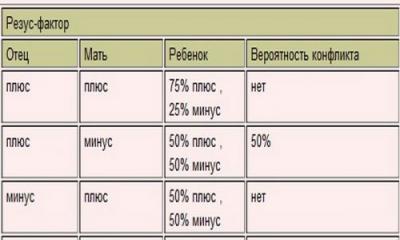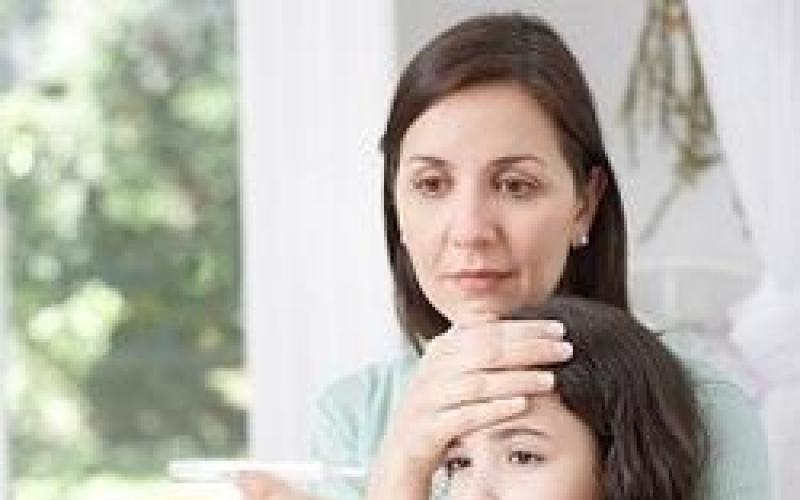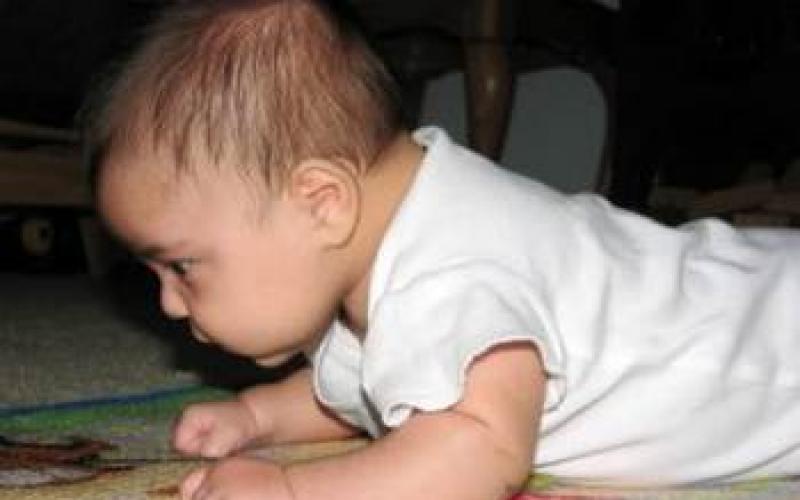Temperature is one of the vital signs of our body, which depends on many physiological factors. The thermoregulatory system, which is centered in the hypothalamus, maintains an optimal temperature and regulates the balance between heat loss and generation in the body.
At birth, the thermoregulation system is still imperfect, so the body of children under the age of 3 months is not able to constantly maintain the temperature and reacts to any fluctuation in the temperature regime of the environment. It is for this reason that the doctors of the maternity hospital recommend that you properly care for the child and prevent overheating or hypothermia.
In some children, a temperature of up to 39 degrees can be observed 3-5 days from birth. This only suggests that their body is adapting to life in a new environment, outside the womb. Closer to 3 months of age, the formation of circadian rhythms begins, and at night the thermometer indicator will stop at 37 degrees. The maximum indicator can be observed in the evening.
When measuring the temperature of a newborn, you need to know that the temperature will differ in different parts of the body. Therefore, every mother should take into account that in the armpit the indicator will be 0.3-0.6 degrees lower than in the rectum.
Normal body temperature in a newborn baby is considered to be up to 37.5 degrees. But in some cases, you can also find individual fluctuations in body temperature from 35 * C to 38.3 * C. To measure it, use a mercury or electronic thermometer.
Symptoms of fever in newborns
The first symptoms of fever in a newborn baby:
Rapid breathing and pulse
anxiety,
lethargy
pallor skin or their redness.
shiny eyes
sweating
chills.
 Rapid breathing and heart rate are considered the most important indicators of a rise in body temperature. In a healthy child, the pulse rate is reduced no more than 130 times per minute during sleep, and in wakefulness mode - up to 160 beats per minute. When a baby cries, the beats of the pulse can increase up to 200 beats per minute.
Rapid breathing and heart rate are considered the most important indicators of a rise in body temperature. In a healthy child, the pulse rate is reduced no more than 130 times per minute during sleep, and in wakefulness mode - up to 160 beats per minute. When a baby cries, the beats of the pulse can increase up to 200 beats per minute.
The respiratory rate of a newborn baby is up to 60 breaths per minute, while one year old baby - up to 30 breaths. You also need to know that some children normally tolerate a slight increase in body temperature, without any deviations from the norm.
An elevated temperature, which is not a sign of a disease, can reach 38.3 * C in children.... The reason for this may be:
Overheating of the newborn, excessive wrapping or violation of the drinking regime,
constipation,
prolonged crying
teething,
constitutional feature.
Whichever of these causes the fever, it must be eliminated.
1. If the child has been heavily wrapped up or has been in direct sunlight for a long time, then most likely he has overheating. In this case, the child should be taken to a cool room, removed from his clothes and given water.
3. Prolonged crying can cause fever, but parents must establish the true cause of this behavior. If you suspect colic, you should immediately call a doctor.
But it is best not to allow such situations and ensure normal living conditions for the child. Naturally, the process of teething cannot be canceled, and all children, without exception, go through this. Buy teething toys for your child to help her feel better. Do not bring down the temperature if it does not rise above 38.5 * С
In this case, you need to know that the indicator of the thermometer 38 * C may indicate the development of the disease. Most often these are:
Rubella,
chickenpox,
ARVI,
ear-nose-throat diseases.
An increase in body temperature is sometimes observed in a newborn and after vaccination.
Speaking about diseases, it can be noted that the severity of the disease cannot be judged by the thermometer - this is just the body's reaction.
What is the right thing to do for parents with fever in children?
 When the parents of a newborn child notice that his body temperature has risen, the first thing they do is call the pediatrician. This is correct, and each of them must know how to react to the current situation before he arrives.
When the parents of a newborn child notice that his body temperature has risen, the first thing they do is call the pediatrician. This is correct, and each of them must know how to react to the current situation before he arrives.
What body temperature is considered normal, you already know. Therefore, no action should be taken if the thermometer does not exceed 38 * C. More high temperature in children, especially if it is accompanied by other symptoms as well, it is necessary to knock down one of the non-drug methods, which will be described in the article below. Measure your body temperature and write it down each time on a separate sheet, which you will need to show your doctor. Also, do not forget to write down what was the frequency of the measurement procedure.
By the time the doctor arrives, you should explain to him your assumptions about the reason for the increase in temperature, tell what methods you gave your baby to lower the temperature.
You need to call an ambulance in the following cases:
When the temperature in children under 3 months of age,
when the indicator of the thermometer in the armpit shows above 38 * C,
when the baby's neck is not flexible and you cannot tilt his head towards the chest.
if the baby is prone to seizures.
if the temperature is accompanied by vomiting or diarrhea.
the baby refuses to eat for more than 6 hours,
the color of the urine is changed
a rash appeared on the body,
when the child has chronic diseases.
How to bring down fever in children?
First of all, the child should be in a well-ventilated area with normal humidity levels. The air temperature in the room should not exceed 22 degrees. Remember also that electric heaters dry the air, therefore it is recommended to carry out wet cleaning frequently.
Do not worry if the baby eats little with fever and has no appetite - this is considered normal. The main thing is to make sure that he saturates his body with fluid. Therefore, you need to water it often, albeit in small portions.
To reduce the reading of the thermometer, you can wipe the newborn's body with a diaper soaked in warm water... As the moisture evaporates from the skin surface, the body temperature will slowly decrease.
Drinking plenty of fluids is an essential remedy for lowering fever. You will not be able to convince the baby to drink more, but you can offer him often his favorite drinks. If the baby is exclusively breastfed, then breastfeed more often.
Never wipe the body of a newborn with alcohol or vinegar - these are old grandmother's recipes that can only make the situation worse.
Medical methods of lowering the temperature in a newborn baby
The safest medicines for newborns are those products that are made on the basis of paracetamol - Panadol, Efferalgan, Tylenol, etc.
It is strictly forbidden to mix drugs into milk mixtures.... And the main thing that parents should remember, especially when it comes to a newborn child under the age of 3 months, is that the name of the drug, as well as the norms of use, should be prescribed only by the doctor after examining the baby.
The usual body temperature in babies in the first days of life is between 37 and 37.5 degrees. After a few days, it drops to 36-37 degrees, and the baby's condition remains the same. And the usual temperature of 36.6 degrees will be established only when the child is one year old. Parents should know this so as not to worry in case of deviations from the norm.

Up to six months, the child needs to measure the temperature daily
For the first six months, the baby needs to measure the temperature daily. But many parents do not want to run up to the baby with a thermometer every morning. They should always remember that until the child's body has matured enough, the baby can easily overheat. This can happen from active play or strong crying. The child may also be hypothermic from a light breeze or draft.
In newborns, the temperature can drop to 35 degrees. There may be several reasons for this. Among them, the long-lasting effect of antipyretic drugs, if given infant the day before. Even if the child has recovered, it is in the child's body for some time.
Infant body temperature depending on the measurement method
You can measure the temperature of a baby in different ways, so it will be different:

The process of thermoregulation in a newborn child is not formed. At this time, heat transfer prevails, rather than heat production. Babies can get cold, because of this, the child hiccups, arms and legs can turn blue. Children quickly become hypothermic and overheat. This is important to remember for parents who swaddle their children. At this point, the thermoregulation mechanism will not work. Children find it more difficult to adapt to a new environment, and they are prone to colds. In young children, it is important to maintain a normal temperature by caring for them.
How to maintain a normal temperature in a newborn
The smallest children need to create a special thermal regime. To create a comfortable environment, it is recommended to use simple rules:
- In the children's room, it is necessary to maintain a temperature of 20-24 degrees.
- A baby's clothes should be one layer more than an adult's.
- The child should not freeze at night. You need to cover it with a natural blanket. It keeps warm, so the baby will have normal thermoregulation.
- For a walk, children need to be dressed according to the temperature regime and weather. Be sure to wear a hat, as a third of the heat is lost if the head is open.
- Immediately after the baby is born, you need to hang a thermometer in the room to monitor the temperature.

How do you know if your baby needs extra warmth?
You can check if your child needs warmth in a simple way. To do this, put a hand on the back of the child's head. He will need additional warmth if the baby has a cool back of the head.
External signs of temperature in a newborn
It is possible to determine whether the temperature is normal in a newborn:
- if the body is warm;
- the skin is pink;
- the child is active.
When the baby has no appetite, the temperature rises, the activity decreases in the warm season, this means that the child is overheated.
What to do when your baby is overheating? Parents can:
- Wear appropriate clothing for the baby: a cotton shirt and a cover sheet.
- Give plenty of fluids.
- Do not take a newborn into the open sun in hot weather, be in the shade with him.
- Put on a panama hat.
- Do not leave the child in the stroller for a long time in the heat, as both the stroller and the child overheat.
The birth of a baby obliges parents to monitor the health of the child and his body temperature. It is especially important to do this constantly for the first few months after the birth of the child.
Temperature norm in babies up to a year
From the moment of birth until the onset of a child of one year, the temperature is considered normal, which can be 37.4 degrees, if measured in the armpits. This is due to the fact that the thermoregulation of the child's body is impaired. It will be established during the first year of life. Therefore, do not worry if the child's temperature rises.

A different temperature is considered normal for each child.
For each baby, the normal temperature will be different, since each child is different. When the temperature rises to 37 degrees, do not worry. If the newborn feels good, eats normally, then you should not worry. The temperature can be slightly lowered. There is nothing wrong with that. This just indicates the developmental features of the baby. It will be correct to measure body temperature over several days. Then you can find out the average value of the indicators for your child.
This is necessary in order to know when to sound the alarm. Recently, it has been noted that at temperatures up to 37.7, babies may not notice the temperature at all. It does not affect the child, who continues to behave naturally.
How to correctly measure temperature in babies?
There are several ways to find out what temperature the baby is. It is believed that the most accurate temperature is shown by a mercury thermometer. However, you need to be careful with him. If the thermometer is damaged, mercury vapor can adversely affect the child's body.
The safest are considered electronic options. They will help determine the temperature faster. Manufacturers now offer several options for electronic thermometers. They can be in the form of a fish, which is applied to the forehead. In the form of a pacifier, which is given to the baby's mouth and thus the temperature is checked.

The measurement method is selected individually
For the rectal method, you can use an electronic thermometer. It is made with a soft tip, and the process itself takes a few seconds. This allows for fast data acquisition and minimizes discomfort.
You need to choose a way to measure the temperature individually. There are active kids who better offer bright toy or a pacifier. The main thing is for the baby to sit for a while.
What temperature is considered high?
Regardless of the disease, the child almost always has a fever. This could be:
- overheat;
- teething;
- reaction to vaccination;
- with dehydration.
The temperature rises to 38.5 degrees, but the baby can safely walk and eat. A wet diaper can be used in this situation. The child is wrapped in it so that the temperature subsides. Later, it may rise again, and the condition of the newborn will worsen. Then it is necessary to give an antipyretic agent. It is important to remember that medications must be approved by the pediatrician. Do not give analgin and aspirin. They lead to complex neurological diseases. Any medications may have no effect when not properly selected. Therefore, in order to avoid negative manifestations, it is better to consult a pediatrician.
Can a baby's temperature go down? Sometimes in infants, the temperature drops to 35 degrees. If the child is playing, feels well, eats, then there is no cause for concern. It could be a simple adaptation. It is quite difficult for newborn babies to immediately rebuild and get used to new living conditions outside the mother's tummy. Therefore, their body can react in different ways.
Newborn babies are still adapting to the new conditions of the surrounding world. And an increase or decrease in temperature can be a simple adaptation to new living conditions. Therefore, you should not call ambulance with slight temperature deviations in one direction or another. It is important to first observe the general condition, sleep, nutrition. If it gets worse, you need to seek medical help.
What does the doctor say to the body temperature of a baby
After a young mother returns with her baby from the maternity hospital, she has a huge amount of worries. Caring for a baby takes a huge amount of energy and attention. One of the main questions that any mother asks is what is the normal body temperature of a baby, and why can it rise? In this case, the concept of "norm" is rather arbitrary, and you should not panic when you see values \u200b\u200bon the thermometer scale above or below 36.6 °.
Important: normal performance for the first days
Features of the body of a newborn
In adults, temperature drops are normally insignificant, and in babies they have a fairly significant amplitude of fluctuations. For young children slight differences values \u200b\u200bin the order of things, since their thermoregulation is not yet perfect, and heat transfer prevails over heat production. The body gives off excess heat through convection from the skin surface, evaporation of moisture during perspiration, and also in the process of exhaling air.
Babies need some time to adapt to environmental conditions. In a month-old child, within one day, the temperature can fluctuate from 36.3 ° C to 37.1 ° C, and this is not considered a pathology. The lowest rates are recorded at 4–5 am, and the highest at 4–17 pm. The daily "spread" often reaches 0.9 ° C at the age of 9 months, and by 2 years it can be even slightly higher.
Note: Cooling hands and feet and hiccupping are important signs that your baby is getting cold. If these symptoms appear, rewarm the baby immediately!
What temperature should a 1-year-old child have?
Although the body temperature of the baby is somewhat labile, there are certain limits within which it can fluctuate.
The values \u200b\u200bthat should not cause much concern for the mother are from 36.3 ° to 37.5 ° C. Normally, in the evening, the temperature rises by a few tenths of a degree, but it decreases while the child is sleeping. In the morning hours, the mercury column usually does not rise above 37.0 ° C.
How is the temperature measured for young children?
Important: it is advisable to use an electronic or infrared thermometer, since mercury can break if accidentally dropped. In addition, the glass body of the latter can be damaged by the kid's sudden movement.
The main methods for measuring temperature are:
- axillary;
- rectal;
- oral;
- in the ear cavity.
 The most common method is to place the thermometer in the armpit... The thermometer is inserted under the baby's handle (making sure that the skin is not sweaty) and pressed tightly. The results are evaluated after 5-7 minutes. It is important that the device is in contact only with the baby's skin, not with clothes; otherwise, the readings will be distorted.
The most common method is to place the thermometer in the armpit... The thermometer is inserted under the baby's handle (making sure that the skin is not sweaty) and pressed tightly. The results are evaluated after 5-7 minutes. It is important that the device is in contact only with the baby's skin, not with clothes; otherwise, the readings will be distorted.
The rectal method involves the introduction of a thermometer into the rectum of the baby... The baby should be placed on his knees so that his legs hang down, and a thermometer should be inserted into his anus, having previously lubricated with baby cream (to minimize discomfort). You can remove the device and evaluate the results in 3-5 minutes.
With the oral method, the thermometer is placed in the baby's mouth... It is important to hold the thermometer and control its position so that the child does not accidentally swallow it while inhaling and does not push it out with his tongue.
 Measuring the temperature in the ear canal (an infrared thermometer is used for this) does not give reliable results in children under 3 months of age due to some peculiarities of metabolism... The data are also distorted with local inflammation (if developed).
Measuring the temperature in the ear canal (an infrared thermometer is used for this) does not give reliable results in children under 3 months of age due to some peculiarities of metabolism... The data are also distorted with local inflammation (if developed).
Important: in humans, the temperature in the rectum is higher than in the armpit. The difference is up to 1 degree. On the other hand, with the oral measurement method, you can get slightly underestimated data. The temperature in the ear cavity is 0.6-1.2 degrees higher than under the armpit.
Standards for different measurement methods:
- axillary - 36.0 ° -37.3 ° C;
- rectal - 36.9 ° -38 ° C;
- oral - 36.6 ° -37.2 ° C
Probable causes of subfebrile condition in children
Note: subfebrile condition is an increase in body temperature within 38.0 ° C.
If the temperature is above normal, the general condition of children usually changes as well. The child becomes restless, cries often, and refuses to eat (or eats very little). His skin may feel hot to the touch. Sweating is often observed, and the pulse is rapid. Many children have disturbed sleep - they do not fall asleep well, and often wake up at night.
Of course, infections are the most unpleasant cause of fever. In newborns, it is very weak, so even a lung that an adult will not notice can turn into serious problems for a baby. Subfebrile condition for a long time can be caused by a chronic inflammatory process.
A common cause of fever in babies is... It begins on average at 6 months of age. In addition to hyperthermia, the child has restless behavior, disturbed sleep, increased salivation, fever, swelling and redness of the gums. It develops quite often. During this period, the temperature can rise by 2 degrees or more.

Note: fever is not a pathology, but just one of the symptoms of certain processes in the body. Hyperthermia accelerates biochemical reactions, during which the biosynthesis of the body's natural defenders - interferons - is accelerated. Besides, elevated temperature itself is detrimental to a number of infectious agents.
A fairly common reason for a rise in the overall temperature of a baby is overheating.... If it is hot outside or in the room, and (or) the baby is not wrapped up for the weather, the thermometer is likely to show numbers that exceed the norm.
 Another reason for subfebrile condition is often a reaction to vaccinations (for example, administration). A foreign biological material is introduced into the child's body, which causes an active reaction from the immune system. It is almost the same as with any viral infection, therefore, a slight increase in temperature within a few days after vaccination is regarded as normal.
Another reason for subfebrile condition is often a reaction to vaccinations (for example, administration). A foreign biological material is introduced into the child's body, which causes an active reaction from the immune system. It is almost the same as with any viral infection, therefore, a slight increase in temperature within a few days after vaccination is regarded as normal.
In rare cases, hyperthermia becomes a signal of a malfunction of the endocrine glands, the development of autoimmune processes, or the onset of an oncological process. If the baby has a high temperature for a long time for no apparent reason, this is the basis for a comprehensive diagnosis.
What to do if the baby has a high fever?
Readings from 38 ° C and above are cause for concern. In such cases, you must contact your local pediatrician. Febrile values \u200b\u200b(38 ° -39 ° C) are a reason to call an ambulance team, especially if you cannot bring down the temperature on your own. Remember that hyperthermia can provoke .
Even if there are strong assumptions that the hyperthermia is caused by teething, the baby still needs to be shown to the doctor. Chills, hypersalivation, moodiness and other clinical signs are characteristic of many dangerous infections... There is no need to take risks and "write off" fever and other symptoms on the teeth.

Temperature in children younger age it is worth knocking down if the indicators exceed 38 ° C. With lower numbers - only with a clear worsening of the general condition.
It is recommended to start not with antipyretic mixtures and rectal suppositories, but with rubdowns. To carry out them, you need to take ordinary cool water. The child should be watered more often to avoid dehydration; it is important to apply it to the breast more often.
If conservative measures do not give the expected effect, you can resort to drugs. The safest and most effective antipyretic and analgesic drug is considered for children.
Important: in any case, do not self-medicate if the crumbs have these orother chronic diseases (especially of the nervous and cardiovascular systems)!
Dr. Komarovsky talks about effective for children:
How to maintain a normal baby temperature?
there is simple ways, allowing to prevent both overheating and hypothermia of a small child.
where the baby is located should be in the range from + 18 ° to + 22 ° C.
Clothes on a child should be "according to the season" - the same number of layers, as many on an adult plus one more.
It is advisable to cover the baby with a blanket made of natural materials - cotton or wool; this will ensure optimal thermoregulation and avoid overheating.


It is advisable that there is always a wall or table thermometer in the room; with it, you can adjust the temperature.
In the summer (hot weather), only a cotton undershirt is put on the baby, and covered with a regular sheet.
When walking, do not move the stroller to the sunny side.
Even in the shade, you do not need to leave the stroller for a long time.
The baby's head should be covered with a cap or panama.
Important: never leave your baby in a closed car! Remember that overheating can sometimes kill children!
Plisov Vladimir, medical columnist
After the birth of a child, caring parents have many worries. Parents are worried about such questions about whether the baby has enough milk, whether his tummy hurts, whether the temperature rises? Measuring the temperature of a month-old baby is quite problematic, therefore the best way its dimensions are sleep time. After measuring the temperature, parents should assess the condition of the child, because a thermometer value of 37.5 degrees does not always mean that the baby has a fever. Let us examine in more detail what body temperature is normal for children of one month of age.
What temperature is considered normal for a month-old baby
Often parents are concerned about the question of what is the normal temperature in a month-old baby? A month-old baby is considered a newborn, therefore, in the first month of life, the readings of the thermometer can vary from 37 to 39 degrees, which is the absolute norm. A person is used to the fact that a value of 36.6 degrees is considered a normal body temperature. But if you measure the value in an adult, then in rare cases you can find that the mark will stop at the value of 36.6, which is due to various factors.
In a one-month-old baby, the factors of significant differences in thermometer readings include the adaptation of the body to the environment. It follows from this that a value of 37 degrees is considered normal for children in such early age... In addition, thermometer readings for month old baby can range from 36.3 to 38 degrees, which also does not mean that a newborn has a fever.
Having decided what temperature a month-old child should have, you need to figure out how to correctly measure it. After all, there are different ways to measure it:
- in the rectum;
- under the arm;
- in the mouth;
- in the ear.
What are the normal readings of a thermometer in a newborn with different ways measurements. If a measurement is taken in the rectum, then the value should correspond to the norm of 37 degrees. If the thermometer shows a higher value, you should take it under control and measure it regularly. If the values \u200b\u200bdo not decrease, you will need to consult a doctor.
It's important to know! When measuring the temperature in the rectum of a baby, it is imperative to use a special thermometer, and also observe safety rules.
The normal body temperature of a month-old baby, when measured under the arm, is 36.5-37 degrees. When measuring the value under the arm, it is recommended to carry out the procedure while sleeping or feeding the baby. It is important to note that during breastfeeding the reading of the thermometer can rise up to 38 degrees, which is also the norm.
When measuring the temperature in the mouth, you need to know that the norm is 36.8 degrees. For fixation in the mouth of a newborn, it is recommended to use a thermometer in the form of a nipple. The most accurate value can be obtained by measuring it in the ear. To do this, you also need to use a special thermometer, with which you can get accurate values \u200b\u200bin a matter of seconds. The temperature in the ear is considered to be in the range from 36.7 to 36.9 degrees.
What factors affect temperature change
The increase in the thermometer readings in a child at such an early age is influenced not only by the process of adaptation to the environment, but also by the psychological state of the baby. If the baby is not capricious and does not cry, then the thermometer value will not exceed 37.5-38 degrees when measured under the arm. If at rest the parents find high readings on the thermometer, then the measurements should be repeated after 5 minutes. If the value is the same or increases, then appropriate measures must be taken.
It's important to know! If the baby's temperature rises rapidly above 38 degrees, then it is necessary to resort to the use of antipyretic drugs.
After using antipyretics, you need to call an ambulance or a local doctor, who will assess the baby's condition and prescribe the appropriate treatment. A thermometer value of 38 degrees is permissible only if the child is capricious, which happens in frequent cases. You should not rush to call an ambulance in this situation. It is required to wait for the baby to fall asleep in order to re-measure.

The body temperature in children aged from one month to 0.5 years is considered the norm, 37.4 degrees. This is due to the fact that the child's body adapts, the kids are quite mobile and restless, which also affects the readings of the thermometer.
Features of correct measurement
Before sounding the alarm, parents need to know how to properly measure. The most accurate and objective thermometer readings are when the child is sleeping. In this case, it is easier to make a measurement, and the readings will be as correct as possible. It is on the basis of the thermometer readings obtained during the measurement when the baby is asleep that one can draw appropriate conclusions about the state of the crumbs.
Rectal measurement is performed as follows:
- Initially, the child should be placed on the back.
- Lift the legs up or on the side.
- Treat the anus and the tip of a special thermometer with petroleum jelly, then gradually inject.
- The tip of the thermometer should be inserted 1 cm, and the device should be held for 1-2 minutes.

During the introduction of the thermometer, the little one will cry and be capricious, so the thermometer readings will grow rapidly.
Measuring the temperature under the arm is the easiest way, but only if the baby is sleeping. To do this, raise the handle, then put the tip of the device into the armpit, and then press it. It is necessary to hold for 2-3 minutes, but if the baby is asleep, then this is not difficult to do.
For oral measurement, a special electronic thermometer is used, which signals that the readings are ready. The device is installed under the tongue and lasts for about 1 minute. If a nipple is used, then in this case you need to give the little one to chew, and after 30-60 seconds the readings will be ready.
For measurements in the ear, a special device with a limiter is used. It should be carefully inserted into the ear, and after 5-10 seconds the values \u200b\u200bwill be ready. If the measurements are carried out correctly, then the readings at healthy baby will correspond to those described above.
What to do with low thermometer readings
Having figured out the question of what should be the body temperature of a month-old baby, you should figure out what to do if the indicators are below normal? Often, the body temperature of children who were born prematurely decreases. Together with the lowered readings of the thermometer, the child has fatigue, a rare heartbeat, as well as blue fingers. There are children in whom the value on the thermometer drops below 36 degrees during sleep. How many degrees is considered a low body temperature in a child? If the thermometer has difficulty running up to 36 degrees, then this indicates a lowered temperature.
Young mothers are often very concerned about the health of their newborn child. One of the main indicators of well-being in a tiny body is its body temperature. Since birth, it has been repeatedly measured in babies, including in the maternity hospital. This becomes most relevant in situations where there is reason to believe that the child is not feeling well.
Having found numbers on the thermometer that differ from the usual value of "36.6", parents often begin to worry and suspect that their child has the most terrible diseases. Meanwhile, normal body temperature indicators for infants may be different, since their thermoregulation system is not completely formed. In this article, we will tell you what body temperature a month-old baby should have, and at what values \u200b\u200byou can not worry about his health.
What is the normal temperature for a month-old baby?
The body temperature of a month-old baby is 37.0 to 37.2 degrees. At the same time, the thermoregulation system of babies until they turn 3 months is not able to maintain the temperature at the same level, so they very often overheat or overcool.
Since a tiny organism adapts for a long time to new conditions of life outside the mother's tummy, the body temperature of a newborn baby in some cases reaches 38-39 degrees, but, at the same time, does not indicate the development of a disease or an inflammatory process.
In addition, the value of the temperature directly depends on the way it is. So, normal indicators for monthly children are as follows:
- with traditional measurement under the arm, it should be from 36.0 to 37.2 degrees;
- in the mouth - 36.6-37.2 degrees;
- when measured rectally through the anus - 36.9-37.4 degrees.
Of course, with a significant increase in the body temperature of the crumbs, which does not drop for a long time,  a pediatrician should be called. Nevertheless, it should be borne in mind that an increase in the indicator may be associated not only with the development of the disease, but also with other reasons, for example.
a pediatrician should be called. Nevertheless, it should be borne in mind that an increase in the indicator may be associated not only with the development of the disease, but also with other reasons, for example.








